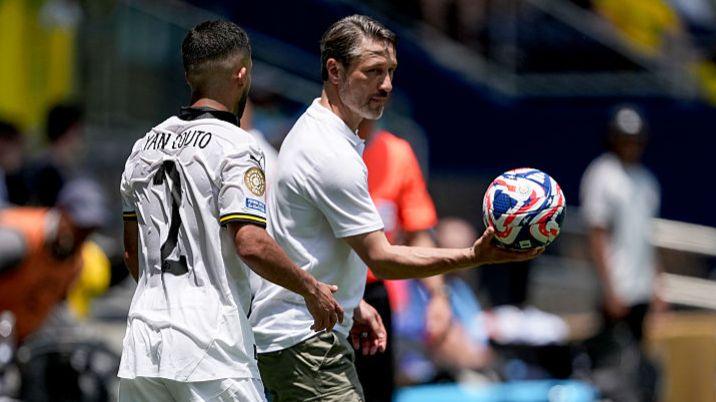After beating Mamelodi Sundowns in 32C heat on Saturday at the Club World Cup in Cincinnati, Borussia Dortmund manager Niko Kovac declared that he was “sweating like I’ve just come out of a sauna.”
The first half was watched from the dressing room by Dortmund’s substitutes, who then hid under umbrellas on the bench for the second half.
Never seen before, but in this heat, it makes sense for our subs to watch the first half from inside the locker room at TQL Stadium.
Before the game, which started at noon local time, Kovac had raised concerns about the conditions.
Both teams had a difficult start, but the opposition [in South Africa] are used to it,” he continued.
A fourth game was postponed due to thunderstorms on Friday, which has continued to affect the Club World Cup.

The delay had caused more than an hour before Mamelodi Sundowns against Ulsan HD in the same city.
And there were lengthy intermissions between Salzburg and Pachuca in Cincinnati and Palmeiras v Al-Ahly in New Jersey (40 minutes).
According to Fossil Free Football, ten games are scheduled for the following week that could result in significant or extreme heat risks.
The United States, Canada, and Mexico are co-hosting the World Cup, which comes just one year after it ends.
According to Dr. Chris Tyler, an expert on heat stress in elite sports, “many of the players who are anticipating competing in 2026 are already getting a taste of what’s in store.”
“Such things will be commonplace, with many of the events scheduled before 5 p.m. to maximize TV audiences.
Extreme heat might turn out to be the tournament’s most formidable adversary.
The dangers that players face

Particular concern is expressed by Fossil Free Football’s predictions for the next two games, which will have a heat index of 38C (Real Madrid vs. Pachuca) and 41C (Benfica vs. Bayern).
This underscores the dangers that players and fans will encounter at this and in 2026. There is little that Fifa can do to calm safety fears.
In Nashville’s 41C on a field with little cover is scheduled for the game between Auckland City and Boca Juniors, which is part-time football in New Zealand.
In the upcoming heatwave, matches will also be played in Philadelphia, New York, Cincinnati, and Washington, DC.
Marcos Llorente described the 32C match as “incredibly hot” and said “my toes were sore, my nails were hurting… it’s incredible.”
Fans complained about long lines and water restrictions when arriving at the stadium and that they had to leave that game due to the heat.
According to a Fifa statement, “Fifa’s top priority is the health of everyone who plays football,” and its medical experts have been in frequent contact with the participating clubs to discuss heat management and acclimatization.
Fans are permitted to bring empty, clear bottles of up to one litre into stadiums as well as cooling breaks in the 30th and 75th minute, respectively.
Los Angeles FC defeated Chelsea 3-1 in their opening game against Flamengo on Friday, making them one of two English teams competing alongside Manchester City.
It pours when it rains.

From a scheduling perspective, there will be concerns about the delays in games in addition to the danger the heat poses to players, staff, and supporters.
For thunder and lightning storms and heavy rain, there were waits of 40 minutes to two and a half hours for four of the first 21 games.
The potential for overlapping matches at the 2026 World Cup won’t disappoint broadcasters.
An hour before Chelsea’s match against Flamengo was scheduled to end, Benfica vs. Auckland City had to come to an end, but the Blues’ defeat came about after the final whistle was blown.
Coach Bruno Lage of Benfica said, “This is the longest game of my career. “Our fans, who have been here for five hours, deserve special appreciation.
related subjects
- Football
Source: BBC

Leave a Reply